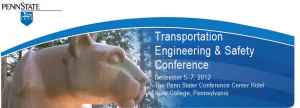PennDOT released their latest edition of Publication 46 – Traffic Engineering Manual in early March. The document, which is dated January 2013, includes new requirements for the performance of traffic impact studies and the associated roadway improvements design. The new manual was discussed at the Penn State Transportation Conference in early December 2012 at which time it was predicted to be released by the end of 2012.
The revisions to the manual include which software packages can be utilized for performing traffic operations analysis and traffic signal system coordination. It also includes changes to the default parameters utilized with the Highway Capacity Manual calculations. The new manual continues to promote the determination of local parameters for the analysis and the performance of multi-period analysis.
As of January 2013 PennDOT now also requires the use of the 2010 Highway Capacity Manual Methodologies in all new traffic studies. While the default factors now included in Pub. 46 are based on a small sample size Benchmark supports their use and the analysis of operational conditions with multi-periods especially when the traffic demand exceeds roadway capacity.
ftp://ftp.dot.state.pa.us/public/PubsForms/Publications/Pub%2046.pdf
The link to the new Pub. 46 Traffic Engineering Manual is below. Paste this link into your browser to view a pdf file of the new manual.
